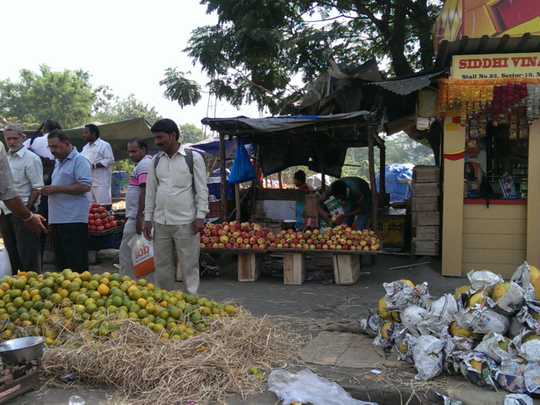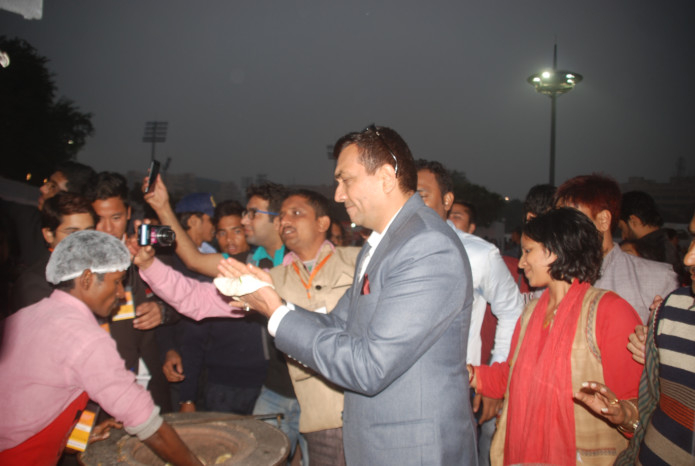
It has been nearly five years since 27-year-old Ramesh Joshi migrated from a small village in the Indian state of Bihar to the national capital New Delhi. Joshi ekes out a living by selling accessories such as hair clips, rubber bands, etc in Lajpat Nagar, a major shopping centre in the city.
Every month he sends money to his family — three siblings and his mother. He is not sure when he would be able to save enough to visit them.
“I make about Rs500-Rs600 [Dh28-Dh33] a day, which is not enough to sustain in this city. I have to somehow manage in order to send some money home. Hopefully my brother, who is 22, might join me soon and together we might be able to earn more,” says Joshi.
Joshi is one of the many in India who migrate to metropolitan cities in search of better prospects. But life as a street vendor is far from easy.
They are regularly harassed by law enforcement agencies. Policemen in India are known to extort “hafta” — a weekly bribe — from these vendors to allow them to conduct business. Many times, the street vendors have to change locations at short notice because of harassment by the police or local goons.
“We live in constant fear of what might happen. Some days we are roughed up, sometimes our stalls are pushed or damaged, or we are asked to move without any notice. The going is very tough for a street vendor in India,” says Haridas Kumra, who has a small “vada pav” stall in Mumbai, the financial capital of India.
On many occasions, the police refuse to return the goods they seized from the vendors, leading to huge financial losses.
According to a 2005 report by the National Alliance of Street Vendors of India (NASVI) — a coalition of about 800 vendor organisations that has been campaigning for vendors’ rights since 2004 — there are nearly 100 million street vendors in India, with 500,000 in Delhi itself..
People from the rural parts of India have for long been migrating to metropolitan cities in search of better economic prospects. But the near collapse of the agriculture sector has forced even the farmers and labourers to seek livelihoods in cities.
“Over the past few decades we can observe that there is a substantial increase in the number of hawkers in major Indian cities. Mumbai has the largest number of hawkers numbering around 200,000. Kolkata has more than 100,000 hawkers. Ahmedabad and Patna have around 80,000 each and Indore, Bangalore and Bhubaneshwar have around 30,000 hawkers,” Sharit Bhowmik says in a NASVI report prepared by him.
The legal angle
Various legal measures are in place to protect vendors’ rights. The Supreme Court declared hawking a fundamental right in 2010.
“The Bench held that structural regulation and legislation is urgently necessary to control and regulate fundamental right of hawking of the vendors and hawkers,” the Supreme Court said. “Considering that an alarming percentage of the population in our country lives below the poverty line, and when citizens by gathering meagre resources try to employ themselves as hawkers and street traders, they cannot be subjected to a deprivation on the pretext that they have no rights.”
Further, the passing of the Street Vendors (Livelihood Protection and Regulation of Street Vending) Bill in 2012 was meant to make life easier for the street vendors. The Act requires local municipal authorities to set up designated vending zones for street vendors. The step is aimed at giving them permanence and to prevent daily harassment. However, few municipalities have implemented it.
The Act stipulates formation of a Town Vending Committee with representation from all stakeholders such as street vendors associations, municipal corporations and the police. Besides, vendors would be provided identity cards to regulate hawking activities in an area.
“As of now only three states — Bihar, Uttarakhand and Karnataka — have started implementing the law. Bihar has started issuing licences to street vendors. We believe that harassment cases are reducing there. The Act is definitely a positive step, but other states also need to implement it at the earliest,” says Anurag Shanker, programme manager at NASVI.
In the rest of the country, the failure to implement the law means street vendors will continue to face harassment.
Some are of the opinion that since the Act requires local municipality’s involvement for implementation, it defies the purpose of a central legislation. Town planners also need to come up with separate areas for street hawkers.
Vendors also point out that the nexus between local politicians and policemen is one of the main reasons for their misery.
“Nearly 56 per cent of India’s GDP comes from the informal sector and street vendors are an integral part of it. The government needs to recognise their contribution,” says Shanker.
Street vendors are typically located at the most convenient points for consumers and are an integral part of middle-class shopping experience in India. Literally everything — from fish to street food to garments and handicrafts — is sold by street vendors.
And hawking their wares on the streets means that they face a number of health issues. “We spend the entire day in the open, be it any season. So that definitely impacts our health. We suffer a number of heat-related ailments during summer. In winter, our business is severely affected because we are able to operate for only a few hours in the afternoon,” says Sunita Rani, 27, who sells handicrafts at Connaught Place in New Delhi.
Some of the common health issues faced by street vendors are hyperacidity and pollution-related ailments. Another major issue for them is the dearth of toilets in India. Female street vendors also face sexual harassment and have to be on their guard all the time.
Most of the street vendors face a huge debt burden. Low income coupled with the high cost of living often forces them to take loans at high interest rates. They have to shell out a significant percentage of their income as interest every month, leaving them with little to get by.
India has the largest population of street vendors in the world and this number is likely to increase as migration from rural to urban areas continues to rise in the wake of the agricultural sector’s collapse. Until the government steps up its efforts, millions of street vendors such as Joshi and Rani will remain extremely vulnerable, living under constant uncertainty and threats.
Gagandeep Kaur is an independent journalist and writes on gender, development and technology. She tweets as @gagandeepjourno













